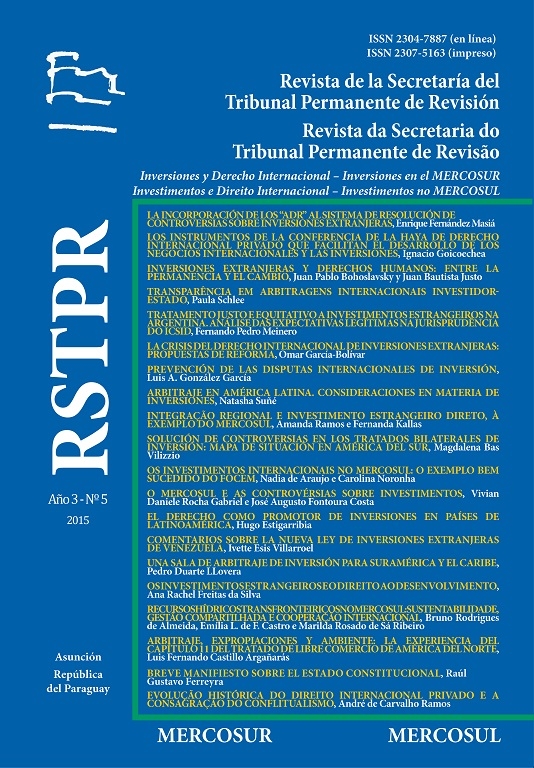Resumen
El derecho internacional condiciona de modo creciente el funcionamiento de los países, al mismo tiempo que presenta problemas de fragmentación que exponen a las autoridades nacionales a señales contradictorias, sobre todo cuando sus diversos subsistemas persiguen objetivos susceptibles de entrar en colisión. Eso es lo que sucede con el régimen de protección de inversiones extranjeras – cuyo funcionamiento actual tiene por objetivo asegurar la estabilidad del entorno jurídico y económico de esas inversiones - frente al régimen de tutela de los derechos humanos - que implica asumir el deber de transformar muchos aspectos de ese mismo entorno para alcanzar las metas de satisfacción de los derechos consagrados en los tratados, en especial en aquellos países más alejados de las condiciones mínimas de disfrute de tales derechos-. Frente a esa potencial tensión, este artículo analiza si el avance en la efectivización de los derechos humanos puede ser interpretado como una violación a los estándares de los tratados bilaterales de protección de inversiones (TBIs), y en su caso, con qué alcance. Para ello estudia tres aspectos del régimen de tutela de los inversores que han dado lugar a reclamos frente a medidas regulatorias que modifican el clima de negocios: trato justo y equitativo, expropiación y cláusulas de estabilización. Por último, y a la luz de la discusión planteada, se estudia la exigencia del consentimiento previo, libre e informado de las comunidades indígenas para el desarrollo de proyectos productivos en sus territorios como una hipótesis concreta en la que la tensión queda puesta de manifiesto, sugiriendo algunas pautas para su abordaje.
Citas
BILCHITZ, David. “The Ruggie Framework: an Adequate Rubric for Corporate Human Rights Obligations?” Sur International Journal on Human Rights. 2010, vol 7, nº 12.
BLITT, Robert C. “Beyond Ruggie’s Guiding Principles on Business and Human Rights: Charting an Embracive Approach to Corporate Human Rights Compliance”. University of Tennessee Legal Studies Research Paper. 2011, nº 158.
BOHOSLAVSKY, Juan Pablo. Tratados de protección de las inversiones e implicaciones para la formulación de políticas públicas (especial referencia a los servicios de agua potable y saneamiento). s.l: CEPAL, 2010.
BOHOSLAVSKY, Juan Pablo y JUSTO, Juan Bautista. “The Conventionality Control of Investment Arbitrations: Enhancing Coherence through Dialogue”. Transnational Dispute Management Journal (TDM). 2013, vol 1.
BURKE-WHITE, William. “International Legal Pluralism”. Michigan Journal of International Law. 2004, vol 25, p. 978.
COTULA, Lorenzo. Foreign investment contracts. s.l: International Institute for Environment and Development, 2007.
DAVITTI, Daria. “On the Meanings of International Investment Law and International Human Rights Law: The Alternative Narrative of Due Diligence”. Human Rights Law Review. 2012, vol 12, nº 3.
DESIERTO, Diane. “Sovereign Policy Flexibility for Social Protection: Managing Regulatory Risk in IIAs. Mauritius International Arbitration Conference. 2012.
DUPUY, Pierre-Marie y VIÑUALES, Jorge. “The Challenge of “Proliferation”: An Anatomy of the Debate”. En: ROMANO, Cesare; ALTER, Karen y SHANY, Yuval (ed). The Oxford Handbook of International Adjudication. Oxford: Oxford University Press, 2014.
GARCÍA DE ENTERRÍA, Eduardo. “El principio de confianza legítima como supuesto título justificativo de la responsabilidad patrimonial del Estado legislador”. Revista de Administración Pública. 2002, nº 159.
JACOB, Marc. “International investment agreements and human rights”. INEF Research PaperSeries Human Rights, 2010, nº 3.
KAUSHAL, Asha. “Revisiting history: how the past matters for the present backlash against the foreign investment regime”. Harvard International Law Journal. 2009, vol 50, nº 2.
LEADER, Sheldon. “Human Rights, Risks, and New Strategies for Global Investment”. Journal of International Economic Law. 2006, vol 9, nº 3.
MONTT, Santiago. “What international investment law and Latin America can and should demand from each other. Updating the Bello/Calvo doctrine in the BIT generation”. En: AA.VV. (ed). El Nuevo Derecho Administrativo Global en América Latina. Buenos Aires, 2009.
OCDE. “Indirect Expropriation” and the “Right to Regulate”. In: International Investment Law. OECD Working Papers on International Investment. 2004/04, p. 3.
ONU. Consejo de Derechos Humanos. Principios Rectores sobre Empresas y Derechos Humanos. Proteger, Respetar y Remediar (A/HRC/RES/17/4, 16 de junio de 2011.
SATTOROVA, Mavluda. “Investment Treaty Breach as Internationally Proscribed Conduct: Shifting Scope, Evolving Objectives, Recalibrated Remedies?” Trade Law & Development.2012, vol 4, nº 2.
SIMMA, Bruno y DESIERTO, Diane. “Bridging the Public Interest Divide: Committee assistance for investor-host State compliance with the ICESCR”. Transnational Dispute Management (TDM). 2013, vol 10.
UNCTAD. Trade and Development Report. Ginebra: UNCTAD, 2014.
UNCTAD. Fair and Equitable Treatment. Ginebra: Naciones Unidas. 2012.

Esta obra está bajo una licencia internacional Creative Commons Atribución 4.0.
Derechos de autor 2015 Juan Pablo Bohoslavsky, Juan Bautista Justo
